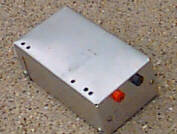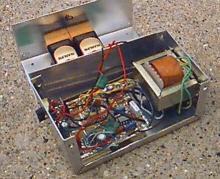Perfect Sine Wave Generator

The perfect (almost) sine wave generator
3x2x5 inches

I built this during Christman vacation, 1987, to see how good of a sine wave I could make. This started when one of my fellow physics grad students asked me if I had any ideas on how to clean up the output of a waveform generator used in the undergraduate labs, to reduce the harmonic content. He wanted to use the generator to demonstrate to students how distortion in audio amplifiers introduces harmonics into an otherwise pure sine wave. Such a demo won't be of any use if the original "pure" sine wave is already full of distortion. So, in the past the instructor would rent an expensive sine wave generator for the day. Would it be possible to obtain a good enough sine wave from the much cheaper waverform generator that the department already owned? (And of course we couldn't steal good equipment from the research groups upstairs.)
Well, the simple solution is to rig up a simple resonant LC circuit, tuned to the fundamental frequency of the sine wave, 1000 cycles per second. Turns out that the signal from the cheap generator, which used an 8038 chip, couldn't be cleaned up that easily. Maybe four or five LC circuits?
I don't know if my colleagues did that or continued to rent the expensive generator, or what. I left the university at the end of that semester, and over Christmas did some thinking as to how to make a perfect sine wave, at least as good as I could make with cheap common parts. It was important to start with a fairly clean sine wave, so it wouldn't need a billion filters to reduce the harmonics. My goal was for all harmonics to be at least 90 db below the fundamental. Another important design point was that active filters couldn't be used, at least not for the final filtering stages, because those would use transistors or op amps which would introduce distortion, due to crossover distortion or nonlinearity.
The best - meaning simple, cheap, and low distortion - basic sine wave generator I found a Wien bridge oscillator using one op amp. The problem with Wien bridge oscillators is that, in order to regulate the amplitude, some sort of nonlinear element has to be used. In many electronics textbooks, one sees a small-power incandescent lamp as part of a voltage divider in the negative feedback loop of the op amp. I found a design that used a different scheme, one that applied very, very gentle control to the amplitude. This means less nonlinearity, thus less distortion. The usual system is good enough for most audio uses, but this new scheme would help me meet my target of -90db harmonic distortion.
In fact, this system worked very well. I wouldn't need much
filtering at all. Just slap on an audio transformer for output,
hang a capacitor across each coil, chosen to be resonant, and
measure. That last step was a bit of a problem, since I finished
the generator when I was at home. My mom wasn't the sort of person
to keep a high quality spectral analyzer around for "just in case";
I had to wait until I could visit Oakland University at the start of
their winter semester, before I could take any measurements.

Look at the schematic as a GIF image, a reduced resolution GIF, or grab the original postscript file.
This generator has two calibration adjustments:
one controls the second harmonic, and can be tweaked to make
the amount of 2nd harmonic exactly zero, and the other
just adjusted the frequency. I had a lot of trouble
measuring the amount of the third harmonic. Not because
of the equipment, but because there just wasn't much there
to be measured. When I finally got a got measurement, I was
disappointed to see it was only -83 db (as I remember)
below the fundamental. Oh, well, life is hard!
Have you built a high-quality sine wave generator? Let me know.
My e-mail address is below. I'll be happy to put in some
links on this page to other sites featuring sine wave generators.
How pure of a sine wave can you make?